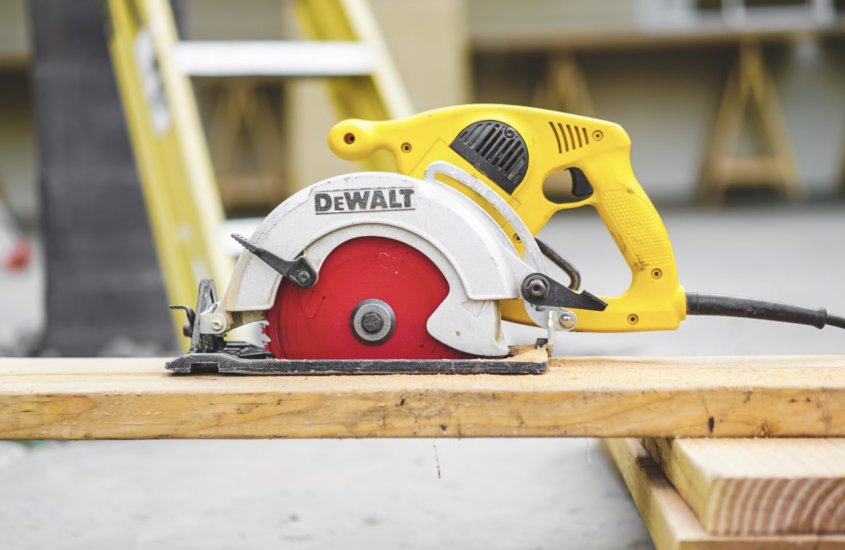How To Use A Circular Saw (Explained)

Any carpenter will tell you, a circular saw is one of their most used tools.
Other trades require this specialized tool, too, as it can achieve a precise, clean cut through various types of materials.
Circular saws take the hard work out of sawing a piece of material and trying to get an accurate, clean cut.
Instead of spending a long time cutting the material, a circular saw allows you to cut straight through in only a few seconds. And, using this tool is surprisingly simple.
When using a circular saw, you just need to set the blade to the correct depth and angle, line it up with the material you wish to cut, and then smoothly glide the saw over the area which you want to cut.
However, before you start sawing, you need to familiarize yourself with a circular saw and ensure that you have taken all the necessary precautions.
In today’s guide, we will be guiding you through how to use a circular saw safely and properly.
By the end of this article, you will be in a much better position to tackle those DIY projects around your house that you have been putting off for some time.
Let’s get started.
Table of Contents
How To Use A Circular Saw
Now you know the different components that make up a circular saw, let’s find out how to use one correctly.
What you’ll need:
- A circular saw
- Eye protection
- Safety gloves
- The first step is to mark out where you want to cut the material you are using. Now, take note of the marking that shows “0°” on the base plate. Sometimes, this is shown as two notches. This is the line where the blade will cut through the material. When working without rail support (freehand), you need to follow this 0° mark at all times. You can also follow the blade by observing it from the side too, as an alternative, but these cuts may not be as accurate.
- Once you have marked out your intended cut, clamp the material securely to your workstation. If you have a guide rail, set this up.
- Next, it’s time to adjust the saw’s base plate. Move this so that it’s at the correct height. This is when the blade is a little lower than the material that will be getting cut.
- Set your bevel angle, if you need to cut at different angles.
- Here, you need to rest the baseplate or the show on the edge of the material, close to the cutting line. However, do not allow the blade to touch the material yet.
- Before you start cutting, pull on the trigger and let the blade run to its maximum RPM. When it has reached full speed, you can carefully and slowly push the saw into and through the material.
- Glide the saw through the material. Once it has cut through, release the trigger and wait for the saw to stop.
And, that’s it! You have used your circular saw to cut through whatever material you were using.
Quick Tip: Always position your cut so the piece of material that has been cut falls to the ground automatically. Never start a cut in the middle of two different surfaces as this can result in splintering, kickback, and possible injuries.
How To Change A Circular Saw Blade
Now and again, your saw blade will need to be changed. This can be due to wear and tear or working with different materials.
To change the blade, follow these steps:
- Get the hex key that came with the circular saw (this is usually found on the tool’s body).
- Lock the saw’s blade into position by pushing the lever in on the tool.
- Place the hex key into the bolt and fully unscrew it.
- Take out the flange to remove the blade (it should slide out)
- Replace with your new blade
What Is A Circular Saw?
A circular saw is a type of handheld power tool, specially made to cut through different types of construction materials, such as wood and metal.
These saws come with a very sharp circular blade. This rotates at a high speed, creating rip cuts and cross cuts in the material.
Circular saws come in different sizes so you can tackle different projects more easily.
These different sizes also come with different-sized blades for different materials.
Although you can get corded circular saws, the majority are cordless for improved ease of use.
They are completely portable and are often used by tradesmen, but can also be used at home for DIY projects.
The main advantage of using a circular saw is that it achieves a clean, accurate cut every time.
But, you must learn the different parts of a circular saw and how to use one before you start cutting into anything.
Parts Of A Circular Saw
Circular saws feature an array of different components, with each having a significant purpose.
Here are the parts and what they do on a circular saw:
The Blade
this is the key element of a circular saw as this is what cuts through the material
The Blade Guard
this is an important safety part that stops the material from falling into the blade as it spins. It also acts as a covering to protect you from injury.
Handles
there are two handles; one is on the top of the tool and the other is on the front to help you guide the saw
The Shoe/Baseplate
this glides smoothly over the material that is being cut
Depth Adjustment
as the name suggests, this allows you to alter the height of the saw’s cut to get different material depths
The Bevel Adjustment
this allows you to change the saw’s bevel so you can cut at various angles
The Trigger Switch
this is where you turn the saw on or off
In Summary
A circular saw is an essential tool in any carpenter or tradesman’s armory. It allows you to make precise, clean cuts in a range of materials from wood to plastic.
We hope this guide has helped you understand how to use a circular saw for future DIY projects.
Related Reads
- 4 Types of Range Hoods to Never Buy! (And Why)
- Determining the Ideal CFM for Your Outdoor Range Hood (From the Pros)
- Does an outdoor kitchen need a vent hood?
- Who to Hire for Flawless Outdoor Range Hood Installation
- How to Clean Your Outdoor Hood (3 Simple Steps)







Comments are closed.